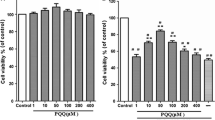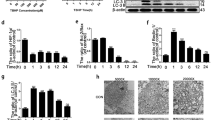Abstract
Background
Oxidative stress in the intervertebral disc leads to nucleus pulposus (NP) degeneration by inducing cell apoptosis. However, the molecular mechanisms underlying this process remain unclear. Increasing evidence indicates that GSK-3β is related to cell apoptosis induced by oxidative stress. In this study, we explored whether GSK-3β inhibition protects human NP cell against apoptosis under oxidative stress.
Methods and results
Immunofluorescence staining was used to show the expression of GSK-3β in human NP cells (NPCs). Flow cytometry, mitochondrial staining and western blot (WB) were used to detect apoptosis of treated NPCs, changes of mitochondrial membrane potential and the expression of mitochondrial apoptosis-related proteins using GSK-3β specific inhibitor SB216763. Co-Immunoprecipitation (Co-IP) was used to demonstrate the interaction between GSK-3β and Bcl-2. We delineated the protective effect of GSK-3β specific inhibitor SB216763 on human NPCs apoptosis induced by oxidative stress in vitro. Further, we showed SB216763 exert the protective effect by preservation of the mitochondrial membrane potential and inhibition of caspase 3/7 activity during oxidative injury. The detailed mechanism underlying the antiapoptotic effect of GSK-3β inhibition was also studied by analyzing mitochondrial apoptosis pathway in vitro.
Conclusions
We concluded that the GSK-3β inhibitor SB216763 protected mitochondrial membrane potential to delay nucleus pulposus cell apoptosis by inhibiting the interaction between GSK-3β and Bcl-2 and subsequently reducing cytochrome c(Cyto-C) release and caspase-3 activation. Together, inhibition of GSK-3β using SB216763 in NPCs may be a favorable therapeutic strategy to slow intervertebral disc degeneration.





Similar content being viewed by others
Data availability
All data generated or analyzed during this study are included in this published article and available from the corresponding author upon reasonable request.
References
Cheng X, Zhang L, Zhang K et al (2018) Circular RNA VMA21 protects against intervertebral disc degeneration through targeting miR-200c and X linked inhibitor-of-apoptosis protein. Ann Rheum Dis 77:770–779
Guo S, Su Q, Wen J et al (2021) S100A9 induces nucleus pulposus cell degeneration through activation of the NF-κB signaling pathway. J Cell Mol Med 25:4709–4720
Kepler CK, Ponnappan RK, Tannoury CA, Risbud MV, Anderson DG (2013) The molecular basis of intervertebral disc degeneration. Spine J 13:318–330
Frapin L, Clouet J, Chédeville C et al (2020) Controlled release of biological factors for endogenous progenitor cell migration and intervertebral disc extracellular matrix remodelling. Biomaterials. https://doi.org/10.1016/j.biomaterials.2020.120107
Grunhagen T, Wilde G, Soukane DM, Shirazi-Adl SA, Urban JP (2006) Nutrient supply and intervertebral disc metabolism. J Bone Joint Surg Am 88(Suppl 2):30–35
Risbud MV, Schipani E, Shapiro IM (2010) Hypoxic regulation of nucleus pulposus cell survival: from niche to notch. Am J Pathol 176:1577–1583
Olmarker K (2005) Neovascularization and neoinnervation of subcutaneously placed nucleus pulposus and the inhibitory effects of certain drugs. Spine (Phila Pa 1976) 30:1501–1504
Suzuki S, Fujita N, Hosogane N et al (2015) Excessive reactive oxygen species are therapeutic targets for intervertebral disc degeneration. Arthritis Res Ther 17(316):1. https://doi.org/10.1186/s13075-015-0834-8
Dimozi A, Mavrogonatou E, Sklirou A, Kletsas D (2015) Oxidative stress inhibits the proliferation, induces premature senescence and promotes a catabolic phenotype in human nucleus pulposus intervertebral disc cells. Eur Cell Mater 30:89–102
Kohyama K, Saura R, Doita M, Mizuno K et al (2000) Intervertebral disc cell apoptosis by nitric oxide: biological understanding of intervertebral disc degeneration. Kobe J Med Sci 46:283–295
Dal-Pont GC, Resende WR, Varela RB et al (2019) Inhibition of GSK-3β on behavioral changes and oxidative stress in an animal model of mania. Mol Neurobiol 56:2379–2393
Potz BA, Scrimgeour LA, Sabe SA, Clements RT, Sodha NR, Sellke FW (2018) Glycogen synthase kinase 3β inhibition reduces mitochondrial oxidative stress in chronic myocardial ischemia. J Thorac Cardiovasc Surg 155:2492–2503
Farr SA, Ripley JL, Sultana R et al (2014) Antisense oligonucleotide against GSK-3β in brain of SAMP8 mice improves learning and memory and decreases oxidative stress: Involvement of transcription factor Nrf2 and implications for Alzheimer disease. Free Radic Biol Med 67:387–395
Juhaszova M, Zorov DB, Kim SH et al (2004) Glycogen synthase kinase-3beta mediates convergence of protection signaling to inhibit the mitochondrial permeability transition pore. J Clin Invest 113:1535–1549
Risbud MV, Fertala J, Vresilovic EJ, Albert TJ, Shapiro IM (2005) Nucleus pulposus cells upregulate PI3K/Akt and MEK/ERK signaling pathways under hypoxic conditions and resist apoptosis induced by serum withdrawal. Spine (Phila Pa 1976) 30:882–889
Hiyama A, Yokoyama K, Nukaga T, Sakai D, Mochida J (2013) A complex interaction between Wnt signaling and TNF-α in nucleus pulposus cells. Arthritis Res Ther. https://doi.org/10.1186/ar4379
Coghlan MP, Culbert AA, Cross DA et al (2000) Selective small molecule inhibitors of glycogen synthase kinase-3 modulate glycogen metabolism and gene transcription. Chem Biol 7:793–803
Fu P, Arcasoy MO (2007) Erythropoietin protects cardiac myocytes against anthracycline-induced apoptosis. Biochem Biophys Res Commun 354:372–378
Linseman DA, Butts BD, Precht TA et al (2004) Glycogen synthase kinase-3beta phosphorylates Bax and promotes its mitochondrial localization during neuronal apoptosis. J Neurosci 24:9993–10002
Schwabe RF, Brenner DA (2002) Role of glycogen synthase kinase-3 in TNF-alpha-induced NF-kappaB activation and apoptosis in hepatocytes. Am J Physiol Gastrointest Liver Physiol 283:G204-211
Brooks MM, Neelam S, Cammarata PR (2013) Lenticular mitoprotection. Part B: GSK-3β and regulation of mitochondrial permeability transition for lens epithelial cells in atmospheric oxygen. Mol Vis 19:2451–2467
Rodrigues-Pinto R, Richardson SM, Hoyland JA (2013) Identification of novel nucleus pulposus markers: Interspecies variations and implications for cell-based therapiesfor intervertebral disc degeneration. Bone Joint Res 2:169–178
Eom TY, Roth KA, Jope RS (2007) Neural precursor cells are protected from apoptosis induced by trophic factor withdrawal or genotoxic stress by inhibitors of glycogen synthase kinase 3. J Biol Chem 282:22856–22864
Lin J, Song T, Li C, Mao W (2020) GSK-3β in DNA repair, apoptosis, and resistance of chemotherapy, radiotherapy of cancer. Biochim Biophys Acta Mol Cell Res. https://doi.org/10.1016/j.bbamcr.2020.118659
Cross DA, Culbert AA, Chalmers KA, Facci L, Skaper SD, Reith AD (2001) Selective small-molecule inhibitors of glycogen synthase kinase-3 activity protect primary neurones from death. J Neurochem 77:94–102
Kanupriya PD, Sai Ram M, Sawhney RC, Ilavazhagan G, Banerjee PK (2007) Mechanism of tert-butylhydroperoxide induced cytotoxicity in U-937 macrophages by alteration of mitochondrial function and generation of ROS. Toxicol In Vitro 21:846–854
Zhao K, Luo G, Giannelli S, Szeto HH (2005) Mitochondria-targeted peptide prevents mitochondrial depolarization and apoptosis induced by tert-butyl hydroperoxide in neuronal cell lines. Biochem Pharmacol 70:1796–1806
Zhao W, Feng H, Sun W, Liu K, Lu JJ, Chen X (2017) Tert-butyl hydroperoxide (t-BHP) induced apoptosis and necroptosis in endothelial cells: roles of NOX4 and mitochondrion. Redox Biol 11:524–534
Elmore S (2007) Apoptosis: a review of programmed cell death. Toxicol Pathol 35:495–516
Zorova LD, Popkov VA, Plotnikov EY et al (2018) Mitochondrial membrane potential. Anal Biochem 552:50–59
Kalani K, Yan SF, Yan SS (2018) Mitochondrial permeability transition pore: a potential drug target for neurodegeneration. Drug Discov Today 23:1983–1989
Xu X, Lai Y, Hua ZC (2019) Apoptosis and apoptotic body: disease message and therapeutic target potentials. Biosci Rep. https://doi.org/10.1042/BSR20180992
Chong SJ, Low IC, Pervaiz S (2014) Mitochondrial ROS and involvement of Bcl-2 as a mitochondrial ROS regulator. Mitochondrion 19:39–48
Funding
This study was partially supported by grants from the National Key Research and Development Program of China (No. 2016YFA0101300).
Author information
Authors and Affiliations
Contributions
KZ: Acquisition of data, Validation and Methodology, Drafting the manuscript. SG: Drafting the manuscript, Validation and Methodology. GH: Analysis and/or interpretation of data. XQ: Analysis and/or interpretation of data. MM: Acquisition of data. QX: Analysis and/or interpretation of data. WT: Conception and design of study. JT: Conception and design of study. All authors approved to submit this version to this publication.
Corresponding authors
Ethics declarations
Competing interests
The authors declare no conflict of interest.
Ethical approval
This study was performed in line with the principles of the Declaration of Helsinki. Approval was granted by the Ethics Committee of Shanghai East Hospital, Tongji University School of Medicine.
Consent to participate
Informed consent was obtained from all individual participants included in the study.
Consent to publish
The authors affirm that human research participants provided informed consent for publication of the images.
Additional information
Publisher's Note
Springer Nature remains neutral with regard to jurisdictional claims in published maps and institutional affiliations.
Supplementary Information
Below is the link to the electronic supplementary material.
11033_2022_7218_MOESM1_ESM.tif
Supplementary file1 (TIF 1806 kb) Fig. S1 Co-expression of Aggrecan and Collagen II in human nucleus pulposus cells (NPCs). The expression of Aggrecan and Collagen II were mainly in the cytoplasm of NPCs (100×). Scale bars, 100 μm
11033_2022_7218_MOESM2_ESM.tif
Supplementary file2 (TIF 314 kb) Fig. S2 Expression of GSK-3β in human nucleus pulposus cells (NPCs). The expression of GSK-3β was mainly in the cytoplasm of NPCs (100×) Scale bars, 100 μm
11033_2022_7218_MOESM4_ESM.tif
Supplementary file4 (TIF 76 kb) Fig. S4 TBHP caused oxidative stress damage of NPCs. 8-OHdG positive rates at different treating time points as described above. Data are expressed as the mean ± SD. 8-OHdG: 8-hydroxydeoxyguanosine*p < 0.05
11033_2022_7218_MOESM5_ESM.tif
Supplementary file5 (TIF 508 kb) Fig. S5 TBHP caused dysfunction of mitochondrial membrane potential using TMRM and MTG staining. TMRM: Tetramethylrhodamine methylester Scale bars, 50 μm
11033_2022_7218_MOESM6_ESM.tif
Supplementary file6 (TIF 399 kb) Fig. S6 shRNA2 effectively induced the down-regulation of GSK-3β in NPCs. a Western blot analysis of GSK-3β in each treatment group as described above. b The mRNA level of GSK-3β in each treatment group as described above. Data are expressed as the mean ± SD *p < 0.05
Rights and permissions
About this article
Cite this article
Zhu, K., Guo, S., Han, G. et al. GSK-3β inhibition protects human nucleus pulposus cell against oxidative stress-inducing apoptosis through mitochondrial pathway. Mol Biol Rep 49, 3783–3792 (2022). https://doi.org/10.1007/s11033-022-07218-2
Received:
Accepted:
Published:
Issue Date:
DOI: https://doi.org/10.1007/s11033-022-07218-2




